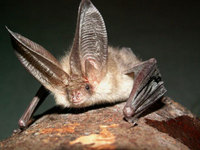The most common house bats

You’d be surprised to know you might have bats living in your house. Since bats’ natural habitat has been lost they’ve adopted all sorts of buildings, houses, barns and even churches as their new roosts. But what bats are you likely to find inside your home?
Pipistrelle bats
The pipistrelle bat is the smallest and most common bat in the United Kingdom. Its fur is a dark red, brown and its body will measure 4.5cm at its largest, that’s less than half the size of an iphone. A pipistrelle bat will eat up to 3,000 insects a night. When they are in mating season, August to September, Males defend their own territories from other males. Females visit these mating roosts, and one male can have a harem of up to 10 females. Find out more about Pipistrelle’s on the BBC’s nature site.
Long Eared Brown Bats
You may also find a Long Eared Brown Bat in your home. Another very common bat in the UK it is perhaps one of the more easily recognisable bats for its name describes it well. Unsurprisingly the Long Eared Brown Bat has very long ears and is brown. The Long Eared Brown Bat’s big ears are used as a predatory tool. You see, some insects have learnt to detect bats’ sonar, so the Long Eared Brown Bat, instead of screaming its sonar, whispers it and when the bat fills its ears with blood they expand and can detect quitter sounds more clearly.
The Long Eared Brown Bat is such a good predator, not only does it have the beautiful big eared advantage it will also hunt as a gleaning bat, meaning that it can pick up grounded prey, usually insects in trees by hovering sort of like a humming bird before its strike.
Serotines are one of the largest UK bats, near enough the same weight as a large mouse. You’ll find this species more in the south England but it’s been as far north as Yorkshire. They’re seemingly dependent on buildings but still roost traditionally. They prefer roof stacks, bat boxes and chimneys. As they are one of Britain’s bigger bats they also create quite large piles of droppings too!
The Greater Horseshoe, Whiskered, Brandt's, Natterer's, Daubenton's and Lesser Horseshoe bat can all be found around roofs of houses but these are much rarer than the first three.
What should you do if you find bats in your house?
Don’t panic. Your house, health and family should not be affected. They will not damage your house.
Very few carry rabies, and they can only pass it on by biting or scratching, which they’ll only do in self defense, so don’t touch them!
You could get a voluntary bat roost visitor to monitor the amount of bats, the type of bats.
If you plan on having any work done to your house make sure you get a bat survey produced in accordance with the Bat Conservation Trust guidelines. Companies like Arbtech will offer this.


